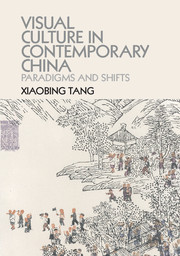Book contents
- Frontmatter
- Contents
- Acknowledgments
- A brief timeline of relevant events
- Introduction Toward a short history of visual culture in contemporary China
- Chapter 1 How was socialist visual culture created?
- Chapter 2 How was socialist visual culture created?
- Chapter 3 What do we see in New China cinema?
- Chapter 4 What does socialist visual experience mean to contemporary art?
- Chapter 5 How (not) to watch a Chinese blockbuster
- Chapter 6 Where to look for art in contemporary China
- Conclusion Seeing China from afar
- Glossary
- List of Illustrations
- Filmography
- Select bibliography
- Index
- References
Chapter 1 - How was socialist visual culture created?
Part I: Revelations of an art form
Published online by Cambridge University Press: 05 January 2015
- Frontmatter
- Contents
- Acknowledgments
- A brief timeline of relevant events
- Introduction Toward a short history of visual culture in contemporary China
- Chapter 1 How was socialist visual culture created?
- Chapter 2 How was socialist visual culture created?
- Chapter 3 What do we see in New China cinema?
- Chapter 4 What does socialist visual experience mean to contemporary art?
- Chapter 5 How (not) to watch a Chinese blockbuster
- Chapter 6 Where to look for art in contemporary China
- Conclusion Seeing China from afar
- Glossary
- List of Illustrations
- Filmography
- Select bibliography
- Index
- References
Summary
We are all convinced that our work will go down in the history of mankind, demonstrating that the Chinese people, comprising one quarter of humanity, have now stood up.
An upsurge in economic construction is bound to be followed by an upsurge of construction in the cultural sphere. The era in which the Chinese people were regarded as uncivilized is now ended. We shall emerge in the world as a nation with an advanced culture.
Mao Zedong, 1949In retrospect, the creation of a socialist visual culture was a grand, exhilarating project that, in the mid-twentieth century, enthralled generations of Chinese artists and left behind a rich and distinct heritage. As we move farther away from the heady days of the socialist revolution, it becomes increasingly evident that the creative project of the bygone era answered forcefully the imperative of cultural transformation that was at the core of China’s search for modernity. It is also clear that the project pointed to a specific vision of becoming modern.
The earliest systematic expression of the transformation imperative was the call for a “New Citizen,” passionately voiced in 1902 by Liang Qichao (1873–1929), a leading advocate for reform in the moribund final years of the Qing dynasty. Only by molding the Chinese into a new and selfconscious nation, Liang reasoned, would it be possible for China to rejuvenate and modernize itself. Ever since the late Qing, the idea of “awakening” the nation became a central motif in modern Chinese political culture.
- Type
- Chapter
- Information
- Visual Culture in Contemporary ChinaParadigms and Shifts, pp. 18 - 60Publisher: Cambridge University PressPrint publication year: 2015

